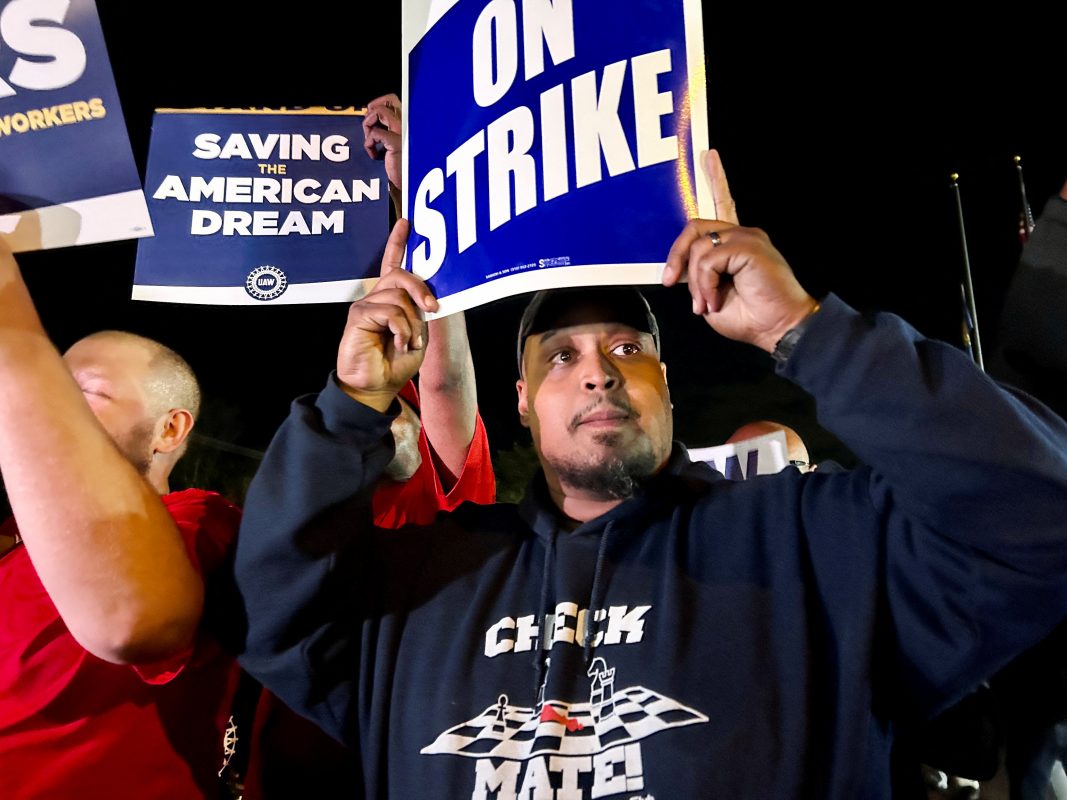DETROIT, (Reuters) – The United Auto Workers union launched simultaneous strikes at three factories owned by General Motors, Ford and Chrysler parent Stellantis today, kicking off the most ambitious U.S. industrial labor action in decades.
The walkouts at the Detroit Three will halt production of the Ford Bronco, Jeep Wrangler and Chevrolet Colorado pickup truck, along with other popular models.
“For the first time in our history we will strike all three of the Big Three,” UAW President Shawn Fain said, adding that the union will hold off more costly company-wide strikes for now, but all options are open if new contracts are not agreed.
Fain laid out plans for the walkouts on Facebook Live, less than two hours before the expiration of the old contract.
The action caps weeks of clashes between Fain and Detroit Three executives over union demands for a bigger share of profits generated by combustion trucks, and stronger job security as automakers shift to electric vehicles.
The executives have said the union’s asks would make the automakers uncompetitive against other non-union rivals. GM CEO Mary Barra told CNBC on Friday that the automaker will keep negotiating, even though she was “frustrated and disappointed” with the strike, which would not be good for the industry.
The standoff has become a political issue, with President Joe Biden, who faces re-election next year, calling for a deal. Biden will address the strike later on Friday, the White House said.
The strikes involving a combined 12,700 workers will take place at assembly plants operated by Ford F.N in Wayne, Michigan, GM GM.N in Wentzville, Missouri and Stellantis’ STLAM.MI Jeep brand in Toledo, Ohio. They are critical to the production of some of the automakers’ most profitable vehicles.
Friday’s walkout was smaller than some analysts expected.
“This is more of a symbolic strike than an actual damaging one,” said Sam Fiorani, a production forecaster at Auto Forecast Solutions, who added that he had expected more in the first wave of the strike.
“If the negotiations don’t go in a direction that Fain thinks is positive, we can fully expect a larger strike coming in a week or two,” he said.
Targeted walkouts could limit the cost of strike pay to the UAW, which has a $825 million strike fund. This pales in comparison to billions the automakers have built up thanks to robust profits from the trucks and SUVs UAW members build.
Stellantis has more than 90 days worth of Jeeps in stock, and has been building SUVs and trucks on overtime, according to Cox Automotive data. But a week-long shutdown at the Toledo Jeep plant could cut revenue by more than $380 million, based on Stellantis financial reports.
Fiorani estimated the limited action would stop production of about 24,000 vehicles a week.
In Wayne, Michigan, hundreds of people, including auto workers on the night shift and their supporters, gathered at a Ford assembly plant as the strike began.
Stellantis shares fell more than 1% in early trading, among the worst performers on the euro-zone STOXX50 .STOXX50 index. Ford shares were down 1.9% and GM was off 1.2% in early premarket trading in New York in thin volumes.
The UAW has said it wants a 40% raise, while the automakers have offered up to 20%, but without key benefits demanded by the union. None of the Detroit Three has proposed eliminating tiered wage systems that require new hires to stay on the job for eight years to earn the same as veteran workers – a key UAW demand.
Ford said the UAW’s latest proposals would double its U.S. labor costs and make it uncompetitive against Tesla TSLA.O and other non-union rivals. A walkout could mean that UAW profit-sharing checks for this year would be “decimated,” it said.
Stellantis said it had immediately gone into “contingency mode” and would take structural decisions to protect the company and its North American operations, without elaborating.
Fain said earlier this week that Stellantis had proposed shutting as many as 18 U.S. facilities.
GM’s top manufacturing executive Gerald Johnson said in a video on Thursday that the UAW wage and benefits proposals would cost the automaker $100 billion. He did not detail how the union proposals would result in that cost, or over what time frame.
“All three will very shortly face difficult legal, financial, operational problems at these plants and with dealers and suppliers,” said Patrick Anderson of Anderson Economic Group in Chicago.
Fain has rejected the automakers’ assertions that union demands would cost too much, saying the companies have spent billions on share buybacks and executive salaries.
Suppliers and other sectors that depend on automakers and their workers could see demand and cash dry up if the strike is lengthy.
While Biden is pouring billions in federal subsidies into expanding electric vehicle sales, this shift could threaten combustion powertrain jobs and the UAW has not endorsed his re-election.
Biden’s likely opponent, former president Donald Trump, on Friday blasted the shift to EVs as a job-killer for the UAW in an effort to court their votes.
While a deal with one or more of the automakers could come at any time, the disruption is an opportunity for non-union automakers in the United States, including Tesla, Toyota 7203.T, Honda 7267.T and Mercedes MBGn.DE.
Those non-union factories, plus imports, account for more than half of the vehicles sold in the U.S. market.
A full strike would hit earnings by about $400 million to $500 million at each affected automaker per week of lost production, Deutsche Bank estimates. Some of those losses could be recouped by later boosting production schedules, but that possibility fades as a strike extends to weeks or months.
